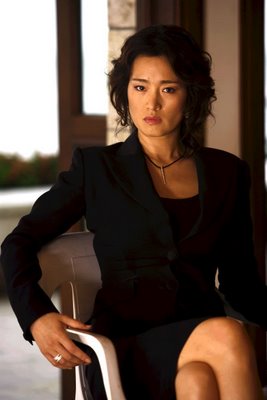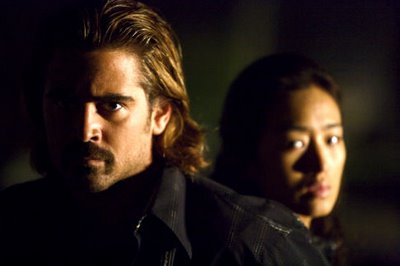las virtudes del HD (mas Miami Vice)

From the Los Angeles Times.... interesante nota sobre las maravillas de la Alta Definicion
PERDIDO será, x cierto, en HD
`Vice' and virtues of HD
High-definition video exerts its taxing appeal on a film's makers.
By Susan King
Times Staff Writer
July 27, 2006
"MIAMI VICE" director Michael Mann and his director of photography, Dion Beebe, knew the challenges they'd be facing when they decided to shoot the feature version of the classic 1980s TV series on high-definition video.
Two years ago, Mann and Beebe used high def to shoot "Collateral," which gave the action-thriller set in nighttime Los Angeles a distinctly visceral look. Beebe and co-cinematographer Paul Cameron received an Oscar nomination for their work on that film.
Before the HD cameras rolled in Miami last year, Mann, Beebe and the technical staff spent months in pre-production.
"There's been a lot of debate about high def replacing film and being an easier choice for filmmakers," said the Australian-born cinematographer, who won the Oscar this year for "Memoirs of a Geisha." "But it's definitely not the easy choice."

The high def cameras used in the film weren't made for action-thrillers. "They were designed to be in air-conditioned TV studios mounted on these pedestal tripods run through some sort of control panels," Beebe explained. "The cameras all run off these two recording decks, and you are running cable to recording decks and dealing with heat and moisture. You need a lot of battery power not just to run your cameras, but to run your decks."
Film cameras, he said, are much more robust and can be specifically modified for scenes in speedboats or fast cars. "But these cameras aren't. You have to be determined to see it through. There were often times when we thought it would be easier for us to shoot on film, but we had come down this path and we had done a lot of testing."
So why bother? Several reasons. One is that high-definition cameras allow the image to be manipulated right on the set.
"It's like your television set," Mann said. "You can alter contrast, alter brightness." To be able to adjust those artistic variables while you are shooting "makes it into a much more painterly medium than simply recording on film," he said. "We alter things all the time."
"It's a whole new ballgame for filmmakers to have that ability [to adjust] right in front of you," Beebe agreed.
The high-definition cameras also offer an incredible depth of field, especially at night. One can almost sense the humidity and the highly charged atmosphere of nighttime Miami because the cameras capture the billowy clouds, lightning and the lights of the city.

"You wouldn't be seeing any of those lights beyond [the actors] with a normal focal length lens," Mann said. "It would all be out-of-focus dots."
Lighting with HD can be tricky. "When you light with HD, it's sort of like playing a new instrument for us cinematographers," Beebe said. "You have got to get in tune with it and really work its strengths and weaknesses."
They'd already had experience with the technology on "Collateral," but even so, Mann and Beebe spent 4 1/2 months testing the cameras in Miami in conditions similar to what they expected during production of "Miami Vice."


"We shot tests at night, out at sea with helicopters and big boats and freighters," Beebe said. "They were bigger shoot days than I ever had on a feature in Australia — and it was just a test shoot. But the reason was to put ourselves in these situations and ensure we were going to get the results we wanted — securing cameras, [determining] how we were going to power them and cable them and [experimenting with] the settings we were going to choose for them."
AFTER the test footage was shot, Mann and Beebe took it to digital colorist Stefan Sonnenfeld to help devise a formula "for how we were going to use the high definition — how we are going to light it and shoot it," Mann said.
"Miami Vice" was lighted differently than "Collateral." The latter had a "non-directional light" for a softer look, Beebe said. With "Vice," they wanted more of a chiaroscuro-type lighting. "With the shootout at the end, we used these big, hard lights and set out to create a single hard sidelight for the sequence," the cinematographer said. "The problem is maintaining [the lighting] through the sequence because people are moving around and you are changing directions."
Also daunting to film was a scene in which Miami undercover police detective Sonny Crockett (Colin Farrell) takes the beautiful, mysterious Isabella (Gong Li) for a high-speed cruise in a motorboat. The vehicle had to be custom-built. "We needed to run cables through the boat to the cameras," Beebe said. And casings for the recording decks were created so that they could be strapped in the hull of the boat and withstand the impact of the waves.
"Once you take the recording deck off the camera, you can break the camera down to a very small camera," Beebe said, "and we were able to fit the camera with an operator, myself and Michael as well as Gong and Colin and head off at 70 mph across the ocean. It was quite a spectacle to see everyone crammed in the boat."
Although he has now made his last two pictures in high definition, Mann says he hasn't abandoned film. "I could very well do a movie I prefer to shoot on film," he said. "Shooting on film is simpler."

<< Home